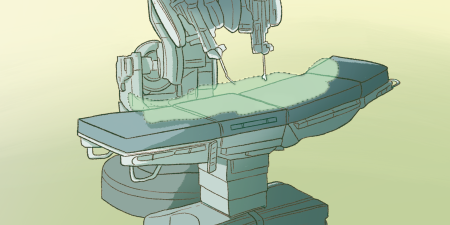Abstract
More frequent use of robotic-assisted surgeries raises several ethical questions about care quality and justice, informed decision making and consent, conflicts of interest, innovation in health care practice, and continuing education. The AMA Code of Medical Ethics does not directly address use of robotic-assisted surgery but offers several relevant opinions.
Robotic-Assisted Surgery
Robotic-assisted surgical procedures have become increasingly common. A recent cohort study found that the use of robotic surgery for all general surgery procedures performed between 2012 and 2018 increased from 1.8% to 15.1%.1 Robotic-assisted surgery will likely continue to grow its market share. In 2022, the global surgical robotics market was valued at 6.3 billion USD, and it is expected to expand at a compound annual growth rate of 15.9% from 2023 to 2032, with a projected 2032 value of 26.8 billion USD.2
Despite the rapid development of robotic surgical technology, its cost-effectiveness—due to the initial purchasing cost—and maintenance are major issues.3 Furthermore, the long-term survival benefits of robotic-assisted surgeries compared with traditional surgeries have not yet been established, and the US Food and Drug Administration issued a warning in 2019 that patients and doctors should be aware of and discuss the lack of evidence regarding the safety and effectiveness of robotically assisted cancer-related surgeries.4,5 It is also important to recognize that the use of robotic and computer technologies to assist in surgeries requires intensive and continuous training.6 Related to these issues, the increasing use of robotic-assisted surgeries raises several ethical concerns, such as attention to quality and equity of care, conflicts of interest, innovation in medical practice, and continued medical education.
Physicians’ Ethical Responsibilities
Although the American Medical Association (AMA) Code of Medical Ethics does not directly address the use of robotic-assisted surgical procedures, it contains several relevant opinions. Opinion 1.1.3, “Patient Rights,” specifies that patients have the right to “receive information from their physicians and to have opportunity to discuss the benefits, risks, and costs of appropriate treatment alternatives”7—which includes the right to an informed discussion comparing the benefits, risks, and cost of robotic-assisted surgery and traditional surgery. As outlined in Opinion 2.1.1, “Informed Consent,” “[p]atients have the right to receive information and ask questions about recommended treatments so that they can make well-considered decisions about care.”8 With regard to robotic-assisted surgery, such communication is critical, given the often novel and complex nature of robotic technologies that require explanations of the procedure and risks. As with all medical procedures, informed consent is essential to the patient-physician relationship in order to foster trust and support shared decision making.
As addressed in Opinion 1.1.6, “Quality,” physicians are also obligated to ensure that care is “safe, effective, patient centered, timely, efficient, and equitable.”9 Physicians must monitor this technology, much of it novel, to ensure that its use is safe and effective. Because the long-term survival benefits of robotic-assisted surgeries have not yet been established, it is also important that data on long-term outcomes be collected to ensure that outcomes are equitable and not reinforcing systemic inequalities. Attention should also be paid to potential disparities in access to robotic-assisted surgeries among different demographic groups as well as those with different forms of insurance coverage.
When robotic-assisted surgery is part of biomedical research, physicians have an ethical duty to provide “the same care and concern for the well-being of research participants that they would for patients to whom they provide clinical care,” to “advocate for access to experimental interventions that have proven effectiveness for patients,” and to “[b]e mindful of conflicts of interest and assure themselves that appropriate safeguards are in place to protect the integrity of the research and the welfare of human participants,” as outlined in Opinion 7.1.1, “Physician Involvement in Research.”10 In accordance with Opinion 1.2.11, “Ethically Sound Innovation in Medical Practice,” physicians involved in innovative modalities such as robotic-assisted surgery have an ethical duty to design and develop innovations “on the basis of sound scientific evidence and appropriate clinical expertise” and with an awareness “of influences that may drive the creation and adoption of innovative practices for reasons other than patient or public benefit.”11 This duty entails a responsibility to collect and report data on the outcomes of robotic-assisted surgeries and to recognize the financial and other incentives that may motivate the adoption of robotic-assisted surgeries at the organizational level.
As the surgical robotics market continues to grow, physicians must be cognizant of any potential conflicts of interest that relationships with biotechnology or medical device companies driving innovation might pose, such as undue influence by device representatives. On an individual level, to ensure quality care, physicians have a duty to inform patients “of any conflicts of interest [they] … may have in respect to their [patients’] care” as outlined in Opinion 1.1.3.7 Physicians’ primary obligation is to their patients, as detailed in Opinion 11.2.2, “Conflicts of Interest in Patient Care,” which states: “The primary objective of the medical profession is to render service to humanity; reward or financial gain is a subordinate consideration. Under no circumstances may physicians place their own financial interests above the welfare of their patients.”12 Additionally, because robotic-assisted surgery requires expensive equipment, Opinion 9.6.2, “Gifts to Physicians from Industry,” is relevant, as it states how gifts from industry “create conditions that carry the risk of subtly biasing—or being perceived to bias—professional judgment in the care of patients.”13
The use of innovative medical practices comes with a number of ethical considerations, including the need for special training, as Opinion 1.2.11 stipulates. When offering innovative practices such as robotic-assisted surgery, physicians must “[r]efrain from offering such services until they have acquired appropriate knowledge and skills.”11 Implicit in this ethical responsibility is the duty to continual education, detailed in Opinion 9.2.6, “Continuing Medical Education,” which states: “Physicians should strive to further their medical education throughout their careers, to ensure that they serve patients to the best of their abilities and live up to professional standards of excellence.”14 As robotic-assisted surgery continues to advance, physicians have a responsibility to continue their education and to stay up-to-date with these surgical innovations.
References
-
Sheetz KH, Claflin J, Dimick JB. Trends in the adoption of robotic surgery for common surgical procedures. JAMA Netw Open. 2020;3(1):e1918911.
-
Surgical robots market size—by component (robot systems, instruments & accessories), by application (orthopedic surgery, neurosurgery, general surgery, gynecology surgery, urologic surgery), by end-user (hospitals, ambulatory surgical centers) & forecast, 2023-2032. Global Market Insights. April 2023. Accessed April 25, 2023. https://www.gminsights.com/industry-analysis/surgical-robots-market
-
Morris B. Robotic surgery: applications, limitations, and impact on surgical education. MedGenMed. 2005;7(3):72.
- Boyina KK, Dasukil S. Robotic surgery-safety and effectiveness, in comparison with traditional surgery, present context and recent FDA safety warning. Indian J Surg Oncol. 2020;11(4):613-614.
-
FDA in brief: FDA cautions patients, providers about using robotically-assisted surgical devices for mastectomy and other cancer-related surgeries. US Food and Drug Administration. February 28, 2019. Accessed March 10, 2023. https://www.fda.gov/news-events/fda-brief/fda-brief-fda-cautions-patients-providers-about-using-robotically-assisted-surgical-devices
- Diana M, Marescaux J. Robotic surgery. Br J Surg. 2015;102(2):e15-e28.
-
American Medical Association. Opinion 1.1.3 Patient rights. Code of Medical Ethics. Accessed August 24, 2022. https://www.ama-assn.org/delivering-care/ethics/patient-rights
-
American Medical Association. Opinion 2.1.1 Informed consent. Code of Medical Ethics. Accessed August 24, 2022. https://www.ama-assn.org/delivering-care/ethics/informed-consent
-
American Medical Association. Opinion 1.1.6 Quality. Code of Medical Ethics. Accessed August 24, 2022. https://www.ama-assn.org/delivering-care/ethics/quality
-
American Medical Association. Opinion 7.1.1 Physician involvement in research. Code of Medical Ethics. Accessed August 24, 2022. https://www.ama-assn.org/delivering-care/ethics/physician-involvement-research
-
American Medical Association. Opinion 1.2.11 Ethically sound innovation in medical practice. Code of Medical Ethics. Accessed August 24, 2022. https://www.ama-assn.org/delivering-care/ethics/ethically-sound-innovation-medical-practice
-
American Medical Association. Opinion 11.2.2 Conflicts of interest in patient care. Code of Medical Ethics. Accessed August 24, 2022. https://www.ama-assn.org/delivering-care/ethics/conflicts-interest-patient-care
-
American Medical Association. Opinion 9.6.2 Gifts to physicians from industry. Code of Medical Ethics. Accessed August 24, 2022. https://www.ama-assn.org/delivering-care/ethics/gifts-physicians-industry
-
American Medical Association. Opinion 9.2.6 Continuing medical education. Code of Medical Ethics. Accessed August 24, 2022. https://www.ama-assn.org/delivering-care/ethics/continuing-medical-education



